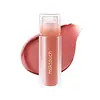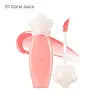What's inside
What's inside
 Key Ingredients
Key Ingredients

No key ingredients
 Benefits
Benefits

 Concerns
Concerns

 Ingredients Side-by-side
Ingredients Side-by-side

Hydrogenated Polyisobutene
EmollientDiisostearyl Malate
EmollientBis-Behenyl/Isostearyl/Phytosteryl Dimer Dilinoleyl Dimer Dilinoleate
EmollientSimmondsia Chinensis Seed Oil
EmollientSilica Dimethyl Silylate
EmollientSynthetic Wax
AbrasivePolyglyceryl-2 Triisostearate
EmulsifyingSorbitan Isostearate
Emulsifying1,2-Hexanediol
Skin ConditioningCetyl PEG/PPG-10/1 Dimethicone
EmulsifyingCI 77891
Cosmetic ColorantPhenoxyethanol
PreservativeCI 15985
Cosmetic ColorantParfum
MaskingCI 77499
Cosmetic ColorantCI 15850
Cosmetic ColorantPrunus Amygdalus Dulcis Oil
Skin ConditioningCI 42090
Cosmetic ColorantPentaerythrityl Tetra-Di-T-Butyl Hydroxyhydrocinnamate
AntioxidantCI 45410
Cosmetic ColorantCI 19140
Cosmetic ColorantHydrogenated Polyisobutene, Diisostearyl Malate, Bis-Behenyl/Isostearyl/Phytosteryl Dimer Dilinoleyl Dimer Dilinoleate, Simmondsia Chinensis Seed Oil, Silica Dimethyl Silylate, Synthetic Wax, Polyglyceryl-2 Triisostearate, Sorbitan Isostearate, 1,2-Hexanediol, Cetyl PEG/PPG-10/1 Dimethicone, CI 77891, Phenoxyethanol, CI 15985, Parfum, CI 77499, CI 15850, Prunus Amygdalus Dulcis Oil, CI 42090, Pentaerythrityl Tetra-Di-T-Butyl Hydroxyhydrocinnamate, CI 45410, CI 19140
Hydrogenated Polyisobutene
EmollientCaprylic/Capric Triglyceride
MaskingDiisostearyl Malate
EmollientPolyglyceryl-2 Triisostearate
EmulsifyingDextrin Palmitate
EmulsifyingSorbitan Isostearate
EmulsifyingSilica Silylate
EmollientCI 77891
Cosmetic ColorantParfum
MaskingCI 19140
Cosmetic ColorantCI 77492
Cosmetic ColorantDehydroacetic Acid
PreservativeCI 15850
Cosmetic ColorantPolyglyceryl-2 Diisostearate
EmulsifyingCI 15985
Cosmetic ColorantCI 45410
Cosmetic ColorantRaspberry Seed Oil/Tocopheryl Succinate Aminopropanediol Esters
Skin ConditioningWater
Skin ConditioningNelumbo Nucifera Flower Extract
Skin ConditioningNymphaea Alba Flower Extract
Skin ConditioningRosa Hybrid Flower Extract
Skin ConditioningPrunus Serrulata Flower Extract
Skin ConditioningPotassium Sorbate
PreservativeGlycerin
HumectantSucrose Palmitate
EmollientHydrogenated Lecithin
EmulsifyingSimmondsia Chinensis Seed Oil
EmollientMacadamia Integrifolia Seed Oil
Skin ConditioningOlea Europaea Fruit Oil
MaskingVitis Vinifera Seed Oil
EmollientHydrogenated Polyisobutene, Caprylic/Capric Triglyceride, Diisostearyl Malate, Polyglyceryl-2 Triisostearate, Dextrin Palmitate, Sorbitan Isostearate, Silica Silylate, CI 77891, Parfum, CI 19140, CI 77492, Dehydroacetic Acid, CI 15850, Polyglyceryl-2 Diisostearate, CI 15985, CI 45410, Raspberry Seed Oil/Tocopheryl Succinate Aminopropanediol Esters, Water, Nelumbo Nucifera Flower Extract, Nymphaea Alba Flower Extract, Rosa Hybrid Flower Extract, Prunus Serrulata Flower Extract, Potassium Sorbate, Glycerin, Sucrose Palmitate, Hydrogenated Lecithin, Simmondsia Chinensis Seed Oil, Macadamia Integrifolia Seed Oil, Olea Europaea Fruit Oil, Vitis Vinifera Seed Oil
Ingredients Explained
These ingredients are found in both products.
Ingredients higher up in an ingredient list are typically present in a larger amount.
Ci 15850 is the pigment color red. It is an azo dye and created synthetically.
Azo dyes need to be thoroughly purified before use. This allows them to be more stable and longer-lasting.
This ingredient is common in foundations, lipsticks, and blushes. This color is described as brown/orangey red.
It has many secondary names such as Red 6 and Red 7. According to a manufacturer, Red 6 usually contains aluminum.
Learn more about CI 15850Ci 15985 is a dye made from petroleum. It is synthetically created and approved by the FDA for use in foods and cosmetics.
The color of this dye is orange/yellow.
This ingredient can be found in makeup, sun care, and skincare.
Learn more about CI 15985CI 19140 is also known as Tartrazine. Tartrazine is a synthetic dye used in cosmetics, foods, and medicine to add a yellow color.
Tartrazine is created from petroleum and is water-soluble.
Some people may experience allergies from this dye, especially asthmatics and those with an aspirin intolerance.
Learn more about CI 19140CI 45410 is a synthetic red-pigment and dye.
It often goes by both Red 28 or Red 27; manufacturers label both ingredients as CI 45410.
This dye is commonly found in makeup because it imparts a vivid color. Some types of this dye change color based on pH level and interaction with moisture:
Your skin has a natural pH of around 4.5 - 5.5.
According to the FDA, CI 45410 is not permitted for use in eye products.
Red 27 is a flourescein dye and commonly used as a fluorescent tracer in medicine.
Learn more about CI 45410Ci 77891 is a white pigment from Titanium dioxide. It is naturally found in minerals such as rutile and ilmenite.
It's main function is to add a white color to cosmetics. It can also be mixed with other colors to create different shades.
Ci 77891 is commonly found in sunscreens due to its ability to block UV rays.
Learn more about CI 77891Diisostearyl Malate is an emollient and most often used in lip products. It comes from isostearyl alcohol, a fatty acid, and malic acid, an AHA.
As an emollient, Diisostearyl Malate helps create a thin film on your skin to trap moisture in. This helps keep your skin soft and smooth.
Hydrogenated Polyisobutene is a synthetic polymer. Polymers are compounds with high molecular weight. Hydrogenated Polyisobutene is an emollient and texture enhancer.
In one study, Hydrogenated Polyisobutene showed better skin hydration levels than Caprylic/Capric Triglyceride. As an emollient, it helps keep your skin soft and hydrated by trapping moisture in.
Hydrogenated Polyisobutene is often used as a mineral oil replacement.
Learn more about Hydrogenated PolyisobuteneParfum is a catch-all term for an ingredient or more that is used to give a scent to products.
Also called "fragrance", this ingredient can be a blend of hundreds of chemicals or plant oils. This means every product with "fragrance" or "parfum" in the ingredients list is a different mixture.
For instance, Habanolide is a proprietary trade name for a specific aroma chemical. When used as a fragrance ingredient in cosmetics, most aroma chemicals fall under the broad labeling category of “FRAGRANCE” or “PARFUM” according to EU and US regulations.
The term 'parfum' or 'fragrance' is not regulated in many countries. In many cases, it is up to the brand to define this term.
For instance, many brands choose to label themselves as "fragrance-free" because they are not using synthetic fragrances. However, their products may still contain ingredients such as essential oils that are considered a fragrance by INCI standards.
One example is Calendula flower extract. Calendula is an essential oil that still imparts a scent or 'fragrance'.
Depending on the blend, the ingredients in the mixture can cause allergies and sensitivities on the skin. Some ingredients that are known EU allergens include linalool and citronellol.
Parfum can also be used to mask or cover an unpleasant scent.
The bottom line is: not all fragrances/parfum/ingredients are created equally. If you are worried about fragrances, we recommend taking a closer look at an ingredient. And of course, we always recommend speaking with a professional.
Learn more about ParfumThis ingredient is a form of glycerin with emulsifying and emollient properties.
As an emulsifier, this ingredient helps keep products together while adding a thick texture. The manufacturer states this ingredient has emollient properties. Emollients help keep the skin hydrated by trapping moisture in.
Polyglyceryl-2 Triisostearate is created by reacting diglycerin and isostearic acid. Due to the isostearic acid base, it may not be safe for Malassezia or fungal acne.
Learn more about Polyglyceryl-2 TriisostearateThis oil comes from the seeds of the desert shrub called Jojoba. It is more commonly known as jojoba oil, a non-comedogenic oil.
Jojoba oil does not contain fragrance and has many fatty-acids, making it a great soothing ingredient.
It also contains Vitamin E, a great moisturizing ingredient. Vitamin E is also an antioxidant and protects your skin against oxidative damage.
This ingredient humectant properties, meaning it helps draw moisture from the air. This helps keep your skin hydrated.
While jojoba has antibacterial properties, it is only able to kill some strains of bacteria.
Studies also show it helps in wound healing. In fact, Indigenous cultures have used jojoba as a moisturizer and to help treat burns for centuries.
Fun fact: Jojoba oil similar to natural human skin sebum, so it has a great effect on dry skin. It is also promising with helping to regulate sebum production.
Due to its fatty acid content, Jojoba oil may not be fungal acne safe. We recommend speaking with a professional if you have any concerns.
Learn more about Simmondsia Chinensis Seed OilSorbitan Isostearate is an emulsifer and cleaning agent. It is created from isostearic acid and sorbitol.
As an emulsifier, Sorbitan Isostearate prevents oils and water from separating.
Due to its isostearic acid base, it may not be safe for Malassezia or fungal acne.
Learn more about Sorbitan Isostearate